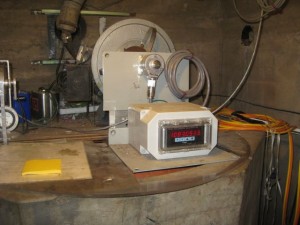Down a long, dank corridor inside Hoover Dam that seems to be known as the “1211 tunnel” (things in the dam tend to be named after their elevation above sea level) and up a flight of stairs sits the top of the dam’s “stilling well”.
It’s essentially a long tube that runs to the bottom of the dam, a little less than three feet wide, with an inlet pipe near the bottom that allows lake water to enter and equalize the height of the water in the well with the lake height outside. It’s the place where Bureau of Reclamation workers measure the surface elevation of Lake Mead. You can see from the picture that it was at 1083.05 and change when I was there this morning (Mon. 10/18). This is the place where the dwindling of Lake Mead is turned into a crisp number.
It is a measurement freighted with meaning. The complex interlocking set of water management rules that govern the allocation of Colorado River water increasingly invoke the number spewed out by the device in the picture. If it gets too low, which it could within the next year (1075 is the magic number), a shortage will be declared and for the first time Colorado River users (Nevada and Arizona in particular) will have their allotments reduced.
If you’ve driven across Hoover Dam, you drove right over the top of it. It sits just beneath the roadway surface, right about the middle of the dam. At Lake Mead’s high point, on July 24, 1983, the water was just three feet below the top of the well. When I was there this morning, the water was 146 feet below the top of the well. As I think I have mentioned previously, that is the lowest the lake has been since they filled it in the 1930s.
Felicity Barringer had a great quote this morning from Barry Nelson at the NRDC:
This strikes me as such an amazing moment. It’s three-quarters of a century since they filled it. And at the three-quarter-century mark, the world has changed.
Teofilo is right when he points out that the milestone is “more symbolic than practical”. The lake looked pretty much the same to me today as it did yesterday, and not all that different from my last visit to Hoover Dam back in April.
But symbols are storytelling tools, and records (“the lowest in history”) are things people can relate to as we undertake the next steps in our conversation about western water.
(For more on the record, Bryan Walsh has a nice summary of the state of the lake and climate change implications.)


These Colorado River updates are fascinating- keep them coming!
Last weekend 16,000 visitors for the bridge opening. Numerous journalists. The main event.
Today, the lake level in the stilling well at Hoover Dam. One journalist.
Both, events of note.
Pingback: This Is Huge « Follow the Energy
Pingback: Didion on Water : jfleck at inkstain